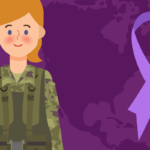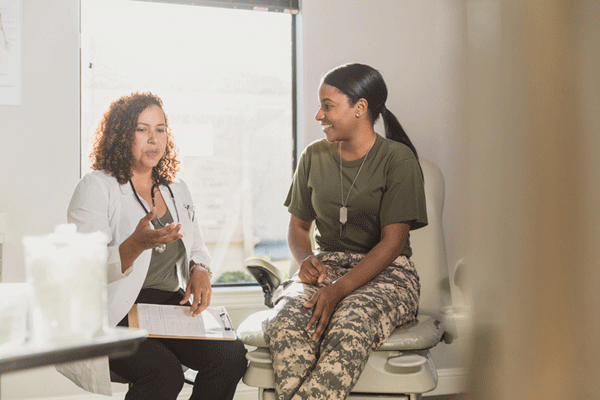Reviewed by Lindsey Kirby, PT, DPT
Video/Image |
Voiceover/Audio |
Reducing Pelvic Pain in Servicewomen & Service Members with Female Biology |
[Background music] |
A woman holds her lower abdomen and hip area, and her face reveals that she is experiencing discomfort 1 in 3 female veterans experience pelvic pain An animated close up of the pelvis, showing where pelvic pain typically occurs (pelvic, lower abdomen and female sexual organ region) A military woman (animate the woman one at a time as these words appear)
Graphic suggestion: As the above are listed out, animations to show examples of each |
If you’re feeling discomfort in the lower part of your stomach and pelvic area, you’re likely to be experiencing pelvic pain. Pain that occurs in these areas and lasts longer than 6 months is called chronic pelvic pain.
While this type of pain can occur in all women, chronic pelvic pain is very common in women in the military — both active and veterans. And as many as one in three female veterans experience chronic pelvic pain, compared to one in 10 women who have not been in the military.
Military women have pelvic pain for a variety of reasons. Those on active duty regularly participate in types of high-intensity exercise that can aggravate their pelvic region and make them more prone to injuries in that area. Stress and incorrect breathing techniques while in the field can cause pelvic muscles to tighten up, which can lead to pain. Military sexual trauma and mental health conditions like anxiety, depression and post-traumatic stress disorder (PTSD) can also increase one’s risk of pelvic pain, as can smoking and substance abuse, which some people turn to as coping mechanisms for dealing with a stressful lifestyle. |
Preventing Pelvic Pain |
When it comes to preventing or reducing pelvic pain, being proactive can go a long way. |
Wear properly fitting uniforms The military woman is getting dressed in a uniform and strapping on some equipment to her waist, like a gun holster or body armor vest that is all too big. A big red X appears over the scene and then she gets dressed in a uniform that fits well. |
It’s important to make sure that you’re wearing a properly fitting uniform. Wearing poorly fitting uniforms, like oversized body armor made for men, can put pressure on the pelvic area. Some servicewomen have even experienced pelvic fractures from belts with large metal buckles made for their male counterparts.
|
Exercise and stand with proper form Graphic: The military woman is performing an exercise in the mirror to check her form |
Just about any exercise if performed incorrectly, can strain your pelvic region and lead to pain. So, take time to learn the correct way to perform a strength training or cardiovascular exercise and practice standing with good posture, even when off duty. |
Seek out the help of a pelvic specialist
|
A pelvic specialist can assess your specific condition and personalize a physical therapy protocol for you. |
Stretch regularly The military woman lying on her back with her arms at her side, palms up, with her legs up against a wall The woman getting into child’s pose (where you kneel on the floor with your toes together and your knees hip-width apart, lean forward, and place your forehead on the floor). The therapist uses two hands on hips or mid- and lower back to guide into position (whichever is easier to show). |
Stretching can be a great way to reduce tension in your hips. Lying on your back with your arms at your side, palms up, with your legs up against a wall can help to release some of that tightness. Other positions can also help, like the child’s pose, where you kneel on the floor with your toes together and your knees hip-width apart, lean forward, and place your forehead on the floor.
|
Practice breathing correctly Diaphragmatic breathing The military woman is sitting down with one hand on her chest, the other on her abdomen. Her belly falls as she takes a deep breath. The therapist guides her hand to the diaphragm/stomach region. Actions should line up with the VO. |
Incorrect breathing can lead to tightening of the pelvic muscles. Practicing “diaphragmatic breathing” can relax those muscles. Breathe in slowly from your nose, letting air deep into your belly, then exhale slowly. Your belly should rise and fall with each breath and your chest should remain still. This can help to properly engage your core and can also be used whenever you feel stressed. |
Find a stress management practice The military woman is doing some yoga, tai-chi, meditation |
Stress and anxiety can be another cause of pelvic pain because they can make your pelvic floor tighten. Finding an outlet for stress — whether that’s yoga, tai-chi, mindfulness, meditation — can also help prevent pelvic pain. |
See a therapist The military woman is sitting in a therapist’s office |
Military sexual trauma, PTSD and sexual abuse can also lead to pelvic pain. If things get too overwhelming to manage on your own, make an appointment with a mental health professional. Try to find an expert who has experience treating the condition you’re experiencing. |
How to seek out treatment Graphic: A military woman is talking to her doctor and smiling since she’s about to find relief |
Stigma in the military often results in women being dismissed for pelvic pain and told that it’s all in their head — but this type of discomfort is very real. If you’re feeling these symptoms, speak to your primary care manager and ask for a referral to a pelvic specialist. The sooner you ask for help, the sooner you can find relief. |
For more information, please visit military.HealthyWomen.org. |
|
This resource was created with support from the Ready, Healthy & Able program funders. |
|
















